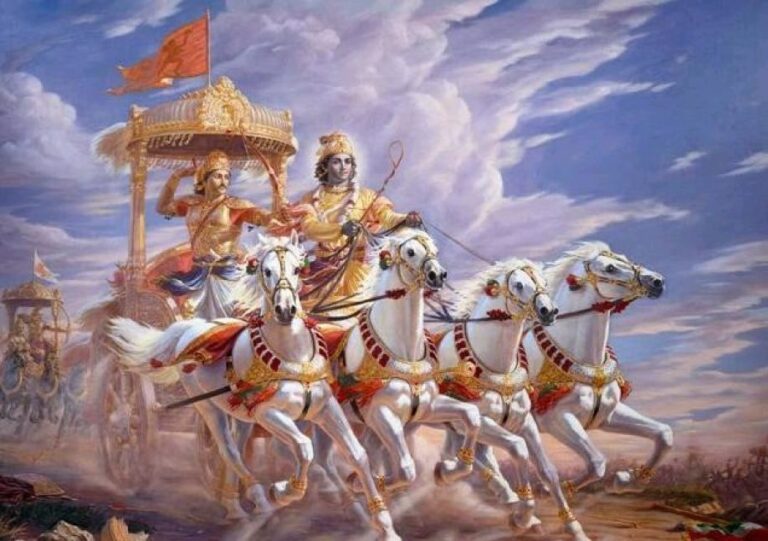
Sadhana
“He whose happiness is within, whose contentment is within, whose light is all within, that yogi, being one with Brahman, attains eternal freedom in divine consciousness”
~ Bhagavad-Gita ~
Sadhana (disciplined spiritual practice) is a very broad term and encapsulates every aspect of one’s life – internal and external. Everything can become a sadhana when performed consciously and with pure intention. It is a means to living life with greater awareness, becoming more conscious so that every aspect of life is performed consciously and thus becomes a sadhana…
Having a daily morning routine and spiritual practice– including yoga asana, pranayama and meditation can help assist in achieving this and as a process of progressing spiritually, bringing about a mental discipline into your life and a process which takes you towards the inquiry into “Self”, supports you in the deep “inner work” and ultimately towards the goal of “Self Realisation”. Sadhana is a conscious activity of spiritual progression and evolution which helps enable connection with the “higher self” / “atman” or soul.
The Bhagavad Gita (an ancient 700-verse Indian Hindu scripture that forms part of the epic “Mahabharata”) – Tells a story of a battle between the Pandavas – symbolising “dharma”, righteousness or the great virtues within us and the Kauravas – symbolising “adharma” that which is non righteous, or the opposing forces within us. It is symbolic and representative of many ethical and philosophical issues, most notably and to simplify – the main struggles in life, in particular our own internal “battles” of and between the heart and mind /intellect. It is a way to understand how we can overcome difficulty, self-doubt, and ultimately how to live a life of real truth and purpose.
It is metaphorical in the sense it is showing us that the natural law of the universe is that everything is moving us towards a higher goal, purpose and expansion of consciousness – rather than things being inherently “good” or “bad”, everything is to be seen as a lesson or opportunity for learning and growth. All lessons / distractions/ events in our lives will inevitably and eventually steer us back on the “right”, path for our highest good.
Krishna gave the message of love and peace in the Bhagavad Gita. He gave his teachings to Arjuna in the battlefield, when he refused to fight against his own family. Krishna advises Arjuna how to complete his duties and become part of the ultimate soul.

It is helpful to understand what each character symbolises in order to make more sense of its deeper meaning:-
Arjuna – Represents you and I standing in the “battle fields” of our own life and minds, facing all the different aspects of ourselves (all our doubts, worries, fears, habits and all that holds us back in life) and that prevent us from realising our true nature.
Krishna – The higher Self, Divine, or God Consciousness.
The Pandavas – The great virtues within us. Representing our Dharma.
The Kauravas – The opposing forces within us. Representing our Adharma
The Chariot – Our physical body.
The Horses – Our five senses that need to be deeply understood in terms of our interaction with the world, our needs, and skilfully guided and governed by the Self in order for us to be able to realise our true nature. (Representing our discipline, focus, attentiveness, awareness).
The Picture of Arjuna and Krishna in the metaphorical “battlefield of life” holding the reins of six horses, therefore symbolises control of the six senses, emotions and desires in order to successfully navigate our way through the ups and downs of life and attain the ultimate goal (self-realization). This comes through our ability to truly understand ourselves, so we can consciously govern our senses, emotions and mind (via sadhana and living by yogic principles), thus operating with greater awareness, clarity, discernment and agility for a smoother journey in life.

Sadhana can help us greatly in achieving this. It does not happen overnight, and is difficult to explain fully as every person’s experience will vary depending on many factors. But to try to simplify and summarise for this purpose, it is usually a slow and gradual process of calming the mind and senses, bringing about increased awareness, expansion of consciousness, purification of the body, and mind. Bringing to the surface/conscious mind and healing deep rooted psychological wounds. This process often involves facing “inner demons” and going through a period of darkness (“dark night of the soul”), then gradual acceptance, deeper realisations, eventually leading to feelings of understanding, expanded awareness, empowerment, clear sense and knowing of self. Leading eventually to immense inner and outer contentment, peace and bliss.
However, it is not a straight linear path and usually within the very early stages of starting and integrating a spiritual practice into one’s life one experiences positive changes for the better. Such as an increased sense of balance, reduced stress, feeling more grounded, greater peace – this happens gradually and you will suddenly start to notice small changes in yourself which consequently have a big impact on your life overall. It helps us to clearly see a higher purpose and meaning behind everything and therefore helps us to see the bigger picture so that we naturally put things into perspective. – This will enable you to feel as though you are able to deal with any situation you are confronted with more easily. Which was my own experience within only a few weeks of introducing a transcendental meditation practice into my routine, about 8 years ago.
With a heightened sense of awareness and sensitivity physically, mentally and spiritually, as a result of the meditation practice, certain things started to happen naturally, without it feeling like an effort. Little by little I made positive changes for the better that didn’t feel like a conscious effort, rather an automatic happening. I started exercising regularly, became super conscious of what I was feeding my body. I naturally became more sensitive, like my body instinctively knew what was nourishing and what was toxifying. I stopped eating non vegetarian food and drinking alcohol, with no effort at all. I just didn’t want these things anymore, I could feel it was not good for me. I felt strong, balanced, and incredibly well, as though anything was possible, for the first time in my life. I had a work-life balance, was doing great in my job, yet still managing to prioritise myself and time for exercise and what I loved and felt I needed. I was researching, learning about nutrition, Ayurveda and various supplements, as well as other spiritual practices I started to integrate into my life. I became very sensitive to energy, and how it affected me. I really started to love understand and care for myself more deeply.
Sadhana is like the steady presence or lighthouse – the inner light within, amidst the stormy sea of life, which helps support us, illuminate and guide our way through.

